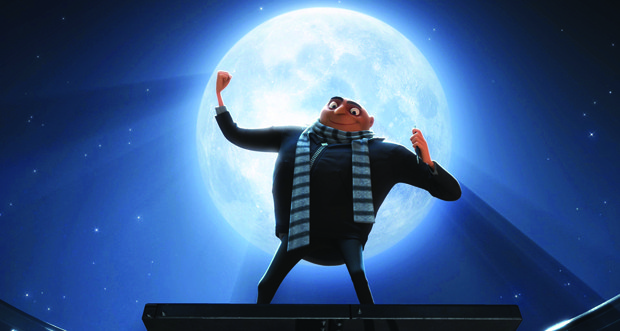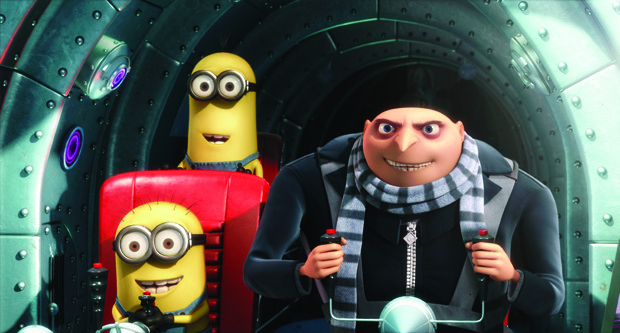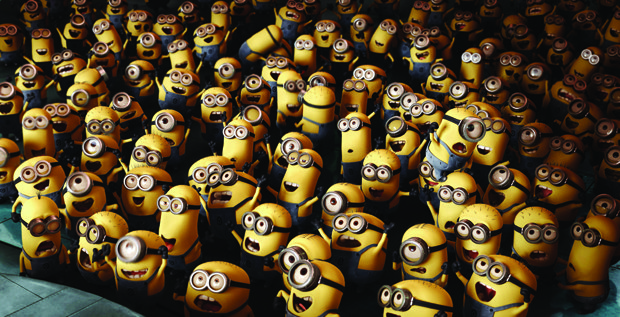Read about the villainy and efficiency behind Illumination's first animated feature made in Paris at Mac Guff.
Check out the Despicable Me trailers and clips at AWNtv!
It was always about villain worship. Even before Chris Meledandri fell in love with the Despicable Me pitch by Sergio Pablos about a super villain charmed and reformed by three little sisters, he wanted to make his first independent animated feature about a baddie protagonist. Boy, did the goth Gru fit the bill with his scheme to steal the moon: Despicable Me, opening today from Meledandri's Illumination Ent. and Universal Pictures, is all about villainy and overcoming bad parenting.
With a nifty concept, Meledandri hired Cinco Paul & Ken Daurio (Horton Hears a Who!) to write the script and Chris Renaud (No Time for Nuts) to be the director in charge of story.
"Gru is dastardly and commits crimes, but making him someone that you want to root for was the first hurdle," Paul recalls. "And the more we found these deliciously evil moments, the more successful we were. Finding ways a normal person wishes he could be a villain."
"We all wish we had a freeze ray gun to skip the whole process of standing in line at Starbucks," Daurio adds. "He has no idea how to deal with children: he's going to give you water, some candy and a newspaper to relieve yourself on."
But after running Fox Animation and overseeing Blue Sky, Meledandri was faced with new hurdles as a startup: where to find a studio?
"I had gone down this path with Blue Sky, which ultimately became modeled in the traditional way of making an animated film," the producer explains. "I wanted to do things similarly and also very differently. For example, the similar thing was that I was going to start a movie with the kernel of an idea, like Ice Age, and develop a story, find the core talent to populate the movie, building the team around it. But there was one missing ingredient: I didn't know where I was going to find 40 great animators. I wasn't going to find them in California because I was a startup. I went on that journey of looking [all over the world]. I went to London first and there were extraordinary possibilities there, but, when I went to Paris and met with four companies, I had some very promising meetings, and when I went to Mac Guff, it was basically a cold call. We sat down and they showed me the work of Pierre Coffin and in that instant I had the same reaction to Pierre's short film work that I had had 13 years earlier when viewing sequences from the unreleased Joe's Apartment, with animation directed by Chris Wedge at Blue Sky. And it was instantaneous that my sensibility drew me to Pierre and he had done most of his work with Mac Guff. And this felt creatively right with me [with Coffin as the director focused on animation]. And I wasn't thinking of any of the pragmatic issues with France."
That came later when Meledandri and Mac Guff owner Jacques Bled actively sought passage of the TRIP (Tax Rebate for International Productions), providing a 20% tax break, with a ceiling of up to 4 million euros per film. "It's millions of dollars in savings and it was conditional for me," the producer says about the first American animated feature made in France. "I had other movies that I could see making in this pipeline." (The next one is Dr. Seuss' The Lorax, to be helmed by Renaud and co-directed by Paul & Daurio).
Yet there were growing pains and cultural differences, to be sure. "But from the outset we had determined that we were going to be on board for an American production," Meledandri emphasizes. "We were going to be efficient, so we were not building into the process a lot of remaking of moments and scenes. We were going to create a structure where we go down a path and stick to that path. And we don't second guess ourselves all the way down that path. Everyone making core decisions were linked together. But, in France, Pierre is used to editing there in 16 minutes, 'and you're telling me we can look at it again tomorrow?' He's collaborative but has clarity of vision. It takes somebody like Janet [Healy] to knit it all together and bring the best of the European and American sensibilities."
Healy, the producer at Illumination in charge of the technical side, having worked at ILM, Disney and DreamWorks, says Mac Guff had a dependable pipeline and could handle scale, having previously made Dragon Hunters. "It was one of the few times that I didn't have to set up a pipeline: Maya front end and a proprietary lighting system back end," Healy says. "There were a lot of process things I had to deal with, to have them scale even further and that they understood the amount of re-do that we were going to need because we're always trying to make the story better. They had really good asset management but not a good reporting system on top of it, so we bought off-the-shelf reporting. It was a good marriage."
To supplement Mac Guff's core animation team, the studio recruited 100 freelancers mostly from Europe. "From the outset, it was astonishing to me how similar the approach was in animation at Mac Guff," Healy continues. "They didn't call their approvals a sweat box, but it was all done from the front end before it goes into the back end of lighting, effects and compositing. All along we talked the same animation language.
"The one thing that was very different was they were used to working with locked story reels. Then they found what the work meant when we said we won't lock anything until we run out of time. It was a little learning curve but they accepted it. In retrospect, what felt daunting in the beginning but now seems commonplace to us was the ability to work across so many time zones efficiently with very little technical infrastructure. We said people need to work where they're most productive and comfortable."
Already with The Lorax, they're experiencing efficiencies and "understanding the complexities in the looks of the pictures and how to operate between departments and across sites. It's making it go faster so we can up the dial a little bit."
According to Paul & Daurio, The Lorax is much more epic than Horton, spanning time and generations. "Our approach is always to expand within the book and not go outside, taking cues from the background artwork and picking up every little clue to fill out the story," Daurio offers.
Bill Desowitz is senior editor of AWN & VFXWorld.










